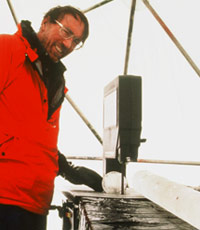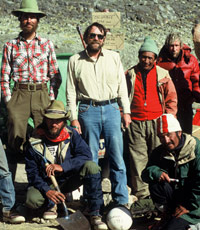

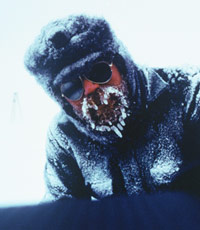
Lonnie Thompson has led or participated on more than 50 expeditions onto glaciers and ice sheets around the world, including to Antarctica in 1974 (above). 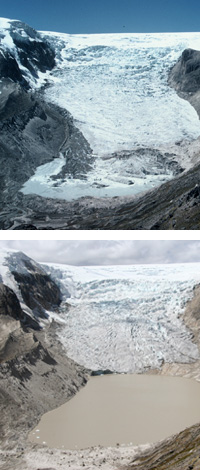
The Quelccaya Ice Cap in Peru has lost more than one-fifth of its area to melting since Thompson and his colleagues began monitoring it in the mid-1970s. Here, Qori Kalis, the largest ice outlet from the Quelccaya, pictured in 1983 (top) and 2008. 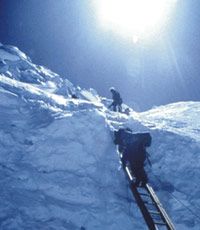
Thompson has done some of his finest work on tropical, rather than polar, glaciers, such as the one seen here—from the inside—atop Peru's Huascarán, the world's highest tropical mountain. 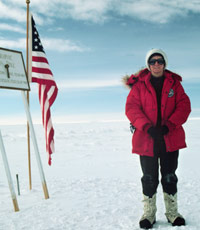
Ellen Mosley-Thompson, also a senior research scientist at the Byrd Polar Research Center, has collaborated with her husband for over a quarter century on glacier studies. Above, she stands at the Geographic South Pole in 1992. 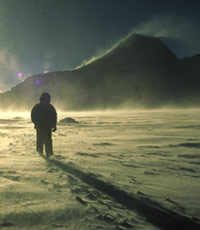
In 1997, Thompson was part of an international team that retrieved the highest ice core ever drilled, high on the flank of Xixabangma, above, a 26,000-foot mountain on the Tibetan Plateau. 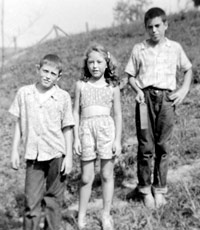
When Thompson first arrived at Ohio State as a graduate student in 1971, he planned to study coal geology, which made sense for someone who had grown up in West Virginia. (Above, young Lonnie, left, in an early photo with his sister Regina and brother Roscoe.) But he soon switched to ice-core work—and never looked back. 
Thompson as a senior in high school. He went on to become one of the pioneers of ice-core research, a science still in its relative infancy. |
For most of us, glaciers are remote. Lying on distant mountaintops or in polar regions, they would seem to have little bearing or impact on our lives. Glaciologist Lonnie Thompson, one of the world's foremost authorities on ancient climate who has led more than 50 expeditions onto the ice, believes we hold such views at our peril. In this interview, hear Thompson, a senior research scientist at Ohio State University's Byrd Polar Research Center and Distinguished Professor of Earth Sciences, explain why today's accelerated melting of glaciers should concern us on fronts as divergent yet as equally critical as drinking water and coastal living, climate change and infectious disease, refugees and terrorism. Big pictureNOVA: In a nutshell, why should we care that all this faraway ice is melting? Lonnie Thompson: Well, first of all, remember that about 10 percent of our planet is covered with ice. It's in remote parts of the world, so most of us don't think about it, but it's extremely important to a lot of different systems on Earth, one of which is sea level. We have a tremendous amount of water tied up in the mountains and ice fields in Greenland and Antarctica, and as temperatures rise, those glaciers will melt. It's really disturbing when you think about our projections. An Intergovernmental Panel on Climate Change report that came out in February, 2007 offered projections for temperatures we might expect on Earth 100 years from now. The projections for temperature rise are about 3°C on average for our planet by 2100. And being a geologist, and having looked at the longer-term history, you say, "Well, how far back do you have to go to get temperatures that were 3°C warmer than today?" You have to go back about three million years; you go back to the Pliocene. Then, if you asked the next question, "Well, what was sea level when the world was three degrees warmer?" It was 25 meters [82.5 feet], plus or minus 10 meters [33 feet], above today's levels. Then you look at how many people live, how many cities are developed on the coastal regions, and you can see the potential risk—economic, social, human—that this poses. Q: And all the ice doesn't have to melt before there are significant problems, right? Thompson: If you lost only 8 percent of the ice out there, sea level would rise five to six meters [16.5 to 20 feet]. Look at the coastline of Florida or New York City or The Netherlands or Bangladesh, and you can see the impacts that would have. A lot of people say, "Well, if it was three degrees warmer three million years ago, we shouldn't be concerned." But the difference is we've never had 6.5 billion people living on the planet depending on those coastal resources. Today we occupy just about every place that humans can occupy. If you displace the coastlines, these people have to go somewhere. All you have to do is look at New Orleans: over 500,000 people displaced [by Katrina]; maybe 400,000 are still displaced. They're living in other cities, different parts of the U.S. What if this occurs on a large scale around the planet? Take a glacier like the Quelccaya Ice Cap in Peru. In the time we've been monitoring it since the mid-'70s, it has lost over 20 percent of its area, a lot more than 8 percent. So the potential implications are huge, and they go into every aspect of human existence. Q: It's not just sea-level rise. Thompson: I think this is what makes this, in my opinion, the most important subject of the 21st century, because of the fact that it's connected to everything we do. If you are looking at the impact of people, migration of people, if you're worried about national security, you look at the projections: What are the parts of the world that are going to be most adversely impacted? They're the tropics, the hot places on the planet. Where do we have the most unstable governments on Earth, the ones we're worried about? In the Middle East, in the tropics. Look at Somalia. Somalia had a weak government, but it had a government until 1993. A huge drought hit the area, the warlords took over, no one's in control. These are hot beds for terrorist development. So there are all kind of ways that these changes work their way through our social systems that I don't think we have actually thought about. Consider bacteria-borne diseases. We're fine if temperatures don't get above 104°F. But if they get above 104°F, we die. So do cows. Mosquitoes are cold-blooded insects. If the mean temperature goes up, they have to feed more often. If they carry malaria, that means they spread the disease more. And with warmer temperatures they can occupy higher elevations in mountain regions and higher latitudes. There are a lot of connections that feed back into the system. Acting globallyQ: So just because you don't live near a coast doesn't mean you should ignore all this melting. Thompson: That's right. When you go to a country like Peru, where 80 percent of the water that produces the country's power comes from glaciers, the loss of that archive becomes a human issue. That water is also used for irrigation and for municipal water supplies, and it's all disappearing. The question is, How do these people adapt to these changes? What do these people need to do to replace what nature has done for free? Well, it'll be looking at things like small dams and the like to retain water during the wet season and release it during the dry season to maintain water flow in the streams. These become big issues, because these are relatively poor parts of the world; they don't have the resources to put these in place. They are also places where there are major earthquakes. You've got to be careful if you're going to build a dam that you don't create other environmental hazards in the process. But we are at the point in the climate-change story where we need to start looking at how people will adapt. Q: And not just in the tropics but in temperate zones as well, right? Thompson: Yes. You can look at the forests in North America and the outbreaks of the beetles, the spruce bark beetle, all through the Rocky Mountains and up through Southeast Alaska. If the winters don't get cold enough to kill back the eggs and the larvae, you have these massive outbreaks, and they kill the trees. Trees are a very important part of our carbon cycle. They take the carbon out of the air, and they solidify it. But suddenly you have millions of acres of stands of trees that are dead, and they're waiting for a match or a lightning strike. Suddenly what had been a store of carbon becomes a source of carbon. And look at the oceans. Every year, humans are emitting something like 26 billion metric tons of carbon dioxide to the atmosphere. This is huge. It far outweighs geologic sources like volcanoes, which emit 300 million to 1.1 billion metric tons a year. Fortunately, the Earth is our friend; over half of that is being sequestered, particularly into the world's oceans. But carbon dioxide is more soluble in cold ocean water than in warm, and the world's oceans are warming. So there's no guarantee as you go forward that these natural storage containers won't reverse and suddenly become sources of carbon to the atmosphere. To me, it's these types of surprises that could take us all off-guard. Q: And this melting, it's not restricted to certain parts of the world. It's happening everywhere, isn't it? Thompson: Well, this to me is the disturbing fact. It doesn't matter whether you're in the Antarctic Peninsula or at the highest mountaintops on Earth or up in southern Greenland or the Arctic Ocean. You're seeing the same thing unfold. If we all lived where these glaciers existed, we would all be much more concerned, as the people who live in these areas who watch them every day are. Because we respond to what we see, and I think as human beings we deal more with crises than we do with planning. Take the Cuyahoga River here in Ohio. It was very polluted. We knew for 15 years it was polluted—science was very clear [on that]. But when did we do something? When it caught on fire. When it caught on fire, that was a crisis. You couldn't ignore it anymore. Suddenly, there was political will. Now that river's been cleaned up. There's walleye and pike and other game fish in the river. When it comes to climate change, you have to ask, okay, what would that crisis be? What would it take? It wasn't the heat wave in Europe in 2003 that killed 35,000 people. It wasn't Katrina here in the U.S. in 2005. We're pretty much on the same path that we have been on. So you have to ask what it would take to get the attention to make that difference. But I'm sure there will be something. And at that time, we will all be on the same page. We will all deal with this issue because we'll have no choice. Getting to the coreQ: So what makes studying the ice itself important? What does it tell us? Thompson: The glacier ice is important for two reasons. One is that it records the history of climate, so it's an indicator of climate change, both in that history and in the way the ice responds to things like warming or cooling temperatures on the planet. But it is also a forcer of climate change, in that it reflects so much of the energy coming from the sun back to space. And as the amount of ice on Earth changes, we change that energy balance for the whole planet. So it has two very important roles to play. But in the ice itself, there is a history written in the annual layers, things like precipitation. Very few [natural] archives on Earth actually record precipitation; it's one of the few that does. And it does it in places where precipitation is very important for people, such as India with the monsoons. How much has precipitation changed [over time]? How many major monsoon failures have there been that could lead to the loss of hundreds of thousands of lives? What is the frequency of those? We don't know. But in the ice at the top of the Himalayas, that history is recorded. The ice also records the forcings of climate, things like volcanic eruptions. When you look at the history of a volcano's eruption, if you go back more than 200 years that record becomes very spotty, because it's dependent on people observing and recording those events. Well, in those annual layers in the ice, by measuring tephra or sulfate from the eruption, you can reconstruct that history long before people were there to observe it. Q: What else? What other inferences can you draw from it? Thompson: Well, you can use the isotopes of oxygen and hydrogen that make up the water molecules in the ice as a proxy for temperature. The ice tells us the conditions at which the snow formed in the past, and if we look at that, we can distinguish seasonal changes, winter snow from summer snow, for instance. There's also a history of things like solar activity—you can look at the 11-to-12-year sunspot cycle. And if you look at pollen, you can tell whether you had mainly grasslands growing around your sample site or whether it was forested, and how that changed through time. In Tibet, for example, we can actually see the maximum progression of the monsoon system into Southeast Asia by measuring the amount of, say, pine pollen. Q: How about organisms like microbes? Do they survive in the ice? Thompson: I'm always amazed that you can find bacteria and viruses in the ice frozen there. Working with the microbiology department here at the university, they've actually been able to resuscitate organisms that have been in the ice for 40,000 to 50,000 years. It gives you some perspective on life. And it needs to be done if you ever hope to go to Mars to look for life—I'd go look at the ice caps on Mars. You have to develop the protocols to make sure that the life you're seeing is in the ice and not something that you took with you from the Earth. Q: And tracking carbon dioxide through history—that's one of the most important things you can do with ice cores, right? Thompson: Yes. If you look at something like carbon dioxide, and you measure the concentration of such gases through time, you get an idea of how they have varied as you go from cold to warm periods. Our oldest records now come from Antarctica; they extend back over 800,000 years. If you look at what the concentration of carbon dioxide was in our atmosphere during the ice ages, you find it's 180 to 200 parts per million by volume. What was it during the warm periods, when the glaciers melted back to the higher latitudes or higher elevations? It was on the order of 280 to 300 parts per million. We're currently at about 385 parts per million. There's no analog to this in the entire 800,000-year time perspective that we've recorded in the ice. So you get an idea of how significant the changes are, and you can actually document how humans are changing the composition of the world's atmosphere. Q: I had no idea there was that much going on in the ice. Thompson: Yes. It's a much better recorder than human-recorded history, I think, because it's done with physics. You look at an isotope, and whatever caused the isotope to form a thousand years ago, the same process is happening today. When you look at a temperature record, a human-made record, you have to be aware that thermometers have advanced, that technology has changed. Ice-core research is a relatively new science—most of the pioneers are still alive—and we're still learning what's in the ice and what you can discover. Q: It must be extremely frustrating to see it all melting. Thompson: Yeah, this was not an issue when we started. I started my degree work here in early '70s, first went to the tropics in the mid-'70s. And if you go back and you look at the history at that time, there was no discussion of global warming. In fact, there was some discussion of a coming ice age and things like that. So when we started, there was no way to see how this would evolve over the next 30 years, to see how the glaciers were going to respond. But I'm glad that we were there to record that, because that gives us a lot of confidence in the variability that exists naturally in the system, but also the role that humans are now playing around the world in the demise of these archives. People powerQ: You've mentioned elsewhere how grateful you are to people in the countries where you've worked, for their help. Thompson: Oh yeah. These programs couldn't be done without the people and the countries where we've worked. I mean, we have tremendous colleagues, and people that you just meet that go out of their way to help you to succeed in what you're doing. To me, this has probably been the most rewarding part of working in 15 different countries around the world. I'll give an example. In 1993, when we were drilling Huascarán [the highest mountain in the tropics, located in central Peru], it was at the height of the Shining Path activity, so there weren't any tourists. There was a risk, but the upside was that, in Huaraz [a town near the mountain], we were given a whole hotel. We set up downstairs—we turned it into a lab—and people slept upstairs. There was a freezer in Huaraz. The man who ran it brought fish from the Pacific Ocean that he would ship over the Andes into the Amazon Basin, and he held it there in this freezer. I told him what we were going to do, that over the next three months we would be sending cores down from Huascarán, and we needed a place to store them. He showed me where he had space [in the freezer], and all during the time we were sending ice down in these core boxes, he was storing it for us. When I came down, he wanted to have the whole crew over to his house for supper, so we went. Toward the end I said, "You know, I need a bill so I can pay you for what you've done here." He looked at me and said, "Lonnie, all I want from you is a letter from your institution saying that I helped." Of course, we did that for him. Now, [this would] never happen in the U.S., but this has repeated itself, whether we're in Peru or Tanzania or Tibet—the remarkable helpfulness, the good nature of people, the desire to help us succeed. That's probably been the most uplifting part of what we do—that these people who in many cases don't even speak your language are willing to help you do your job and actually want to be part of it. I think that's the hope for people. It's not so much what we know, though that's going to be very important for our dealing with these problems. But it is more the human spirit that we can, at least when we have to, work together to do something. |
"If we all lived where these glaciers existed, we would all be much more concerned." "In the mid-'70s, there was no discussion of global warming. In fact, there was some discussion of a coming ice age." "I think that's the hope for people—the human spirit that we can, at least when we have to, work together to do something." |
|||||||||
|
Interview conducted on September 19, 2007 by Dana Rae Warren, producer of "Profile: Lonnie Thompson," and edited by Peter Tyson, editor in chief of NOVA Online |
|||||||||||
|
© | Created April 2009 |
|||||||||||
